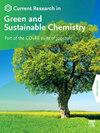利用多元醇为基础的微波辅助萃取技术从可可豆壳中提取化妆品生物活性化合物:细胞毒性、抗酪氨酸酶和抗黑素生成特性
Q2 Materials Science
Current Research in Green and Sustainable Chemistry
Pub Date : 2025-01-01
DOI:10.1016/j.crgsc.2025.100454
引用次数: 0
摘要
可可豆壳是可可工业的主要副产品,具有巨大的增值应用潜力,特别是在化妆品中。本研究的目的是开发一种可持续的、环保的提取工艺,利用微波辅助提取(MAE)和多元醇溶剂提取具有皮肤美白特性的生物活性化合物,这是可可豆壳增值的一种新方法。多元醇,如丙二醇(PG)与乙醇(EtOH)在提取生物活性化合物方面的效率进行了比较。系统评价了多元醇类型、多元醇浓度、料液比、提取温度和提取时间对总酚含量(TPC)、总黄酮含量(TFC)和酪氨酸酶抑制活性的影响。本研究表明,在最佳条件下(60% w/v, 1:50固液比,100°C,提取30 min), PG与EtOH相比,显著提高了TPC(59.57±1.33 mg GAE/g样品),TFC(242.24±2.95 mg QE/g样品)和酪氨酸酶抑制(4.75±0.35 mg KAE/g样品)。LC-QQQ分析发现槲皮素、儿茶素和葫芦巴碱是酪氨酸酶抑制和黑色素含量降低的关键因素,尽管在两种溶剂中槲皮素水平相似,但PG提取物显示出更好的功能活性。比较细胞毒性、抗黑素测定和细胞酪氨酸酶抑制进一步证实了PG提取物比传统乙醇提取物具有更高的安全性和有效性,将其定位为一种新型的绿色溶剂系统,用于开发化妆品配方中有效的皮肤美白活性成分。本文章由计算机程序翻译,如有差异,请以英文原文为准。
Exploration of cosmetic bioactive compounds from cocoa bean shell using polyol-based microwave-assisted extraction: Cytotoxicity, anti-tyrosinase, and anti-melanogenesis properties
Cocoa bean shells, a major byproduct of the cocoa industry, hold significant potential for value-added applications, particularly in cosmetics. The aim of this study was to develop a sustainable, eco-friendly extraction process for bioactive compounds with skin-whitening properties using microwave-assisted extraction (MAE) and polyol-based solvents, a novel approach in cocoa bean shell valorization. Polyols, such as propylene glycol (PG), were compared to ethanol (EtOH) for their efficiency in extracting bioactive compounds. The influence of polyol type, polyol concentration, solid-to-liquid ratio, temperature, and extraction time on total phenolic content (TPC), total flavonoid content (TFC), and tyrosinase inhibitory activity was systematically evaluated. This study demonstrated that PG, at optimal conditions (60 % w/v, 1:50 solid-to-liquid ratio, 100 °C, 30-min extraction), significantly enhanced TPC (59.57 ± 1.33 mg GAE/g sample), TFC (242.24 ± 2.95 mg QE/g sample), and tyrosinase inhibition (4.75 ± 0.35 mg KAE/g sample) compared to EtOH. LC-QQQ analysis identified quercetin, catechin, and trigonelline as key contributors to tyrosinase inhibition and melanin content reduction, with PG extracts demonstrating superior functional activity despite similar quercetin levels in both solvents. Comparative cytotoxicity, anti-melanogenic assays, and cellular tyrosinase inhibition further confirmed the enhanced safety and efficacy of PG extracts over conventional ethanol extracts, positioning them as a novel green solvent system for developing effective skin-whitening active ingredients in cosmetic formulations.
求助全文
通过发布文献求助,成功后即可免费获取论文全文。
去求助
来源期刊

Current Research in Green and Sustainable Chemistry
Materials Science-Materials Chemistry
CiteScore
11.20
自引率
0.00%
发文量
116
审稿时长
78 days
 求助内容:
求助内容: 应助结果提醒方式:
应助结果提醒方式:


